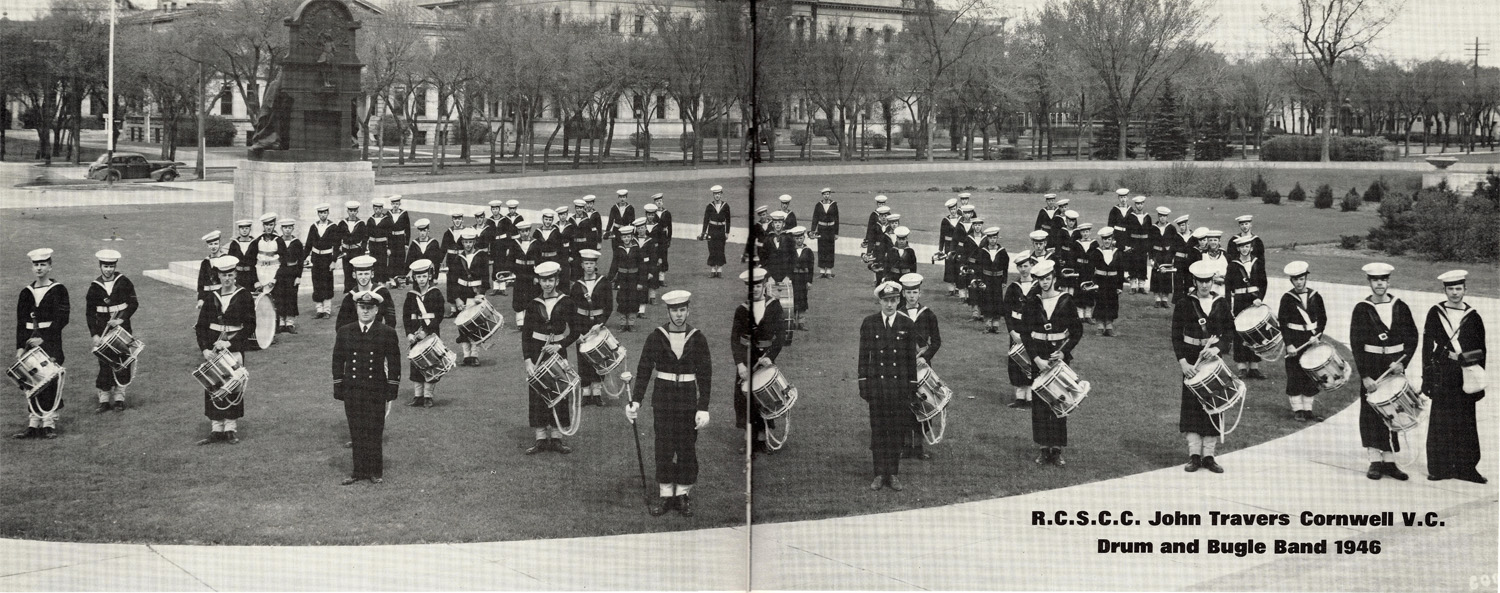

1946

|
The conclusion of the war and the resulting demobilization was to bring change s to R.C.S.C.C. John Travers Cornwell V.C. The anti war feeling prevalent at the end of any world conflict was to result in a slight drop in corps enrollment. However, this setback was more than compensated for in the return home of former officers and cadets.
Lt. W.A. Cramp, corps bandmaster for many years, retired due to ill health in 1946. The contribution that Mr. Cramp made to the cadet movement in Winnipeg can never fully be appreciated. His devotion to the band and his endless patience with the cadets resulted in the best cadet band anywhere in Canada. Upon his retirement he received many letters of thanks from such dignitaries as the Minister of National Defence and the national president of the Navy League of Canada. However, it was the ordinary cadet with musical ambitions that felt his departure the most.
Another long time supporter of sea cadets in Winnipeg also resigned in 1946. Mr. J.D. Ruttan, president of the Manitoba branch of the Navy League turned his position over to Commodore E.R. Brock after 6 years in office. Mr. Ruttan, who guided the unit through the war years and supervised the resulting corps expansion, thanked all those who had given freely of their time and efforts to make his job that much easier. The corps expressed its feeling of loss on Mr. Ruttans decision.
Commodore Brock, until his recent retirement from navy, had served as commanding officer of Naval Services in Ottawa. His decision to accept the position of president of the Manitoba branch of the Navy League, was welcomed by those who knew and appreciated Mr. Brock's abilities. His association with R.C.S.C.C. John Travers Cornwell V.C. began many years before when he was a member of the R.C.N.V.R. in Winnipeg during the 1920'S and 1930's.
On June 24, 1944 the Honourable D. Abbott, Minister of National Defence, lauded the sea cadet movement in Parliament during second reading of a bill to incorporate the sea cadets as part of the naval service. In his address he stated that over 6000 sea cadets had joined the armed forces during World War II. The majority of these recruits had come from the western provinces and special mention was made of the Winnipeg unit, which had been for many years, the largest in Canada.
The end of the war also brought about a reduction of naval space requirements aboard H.M.C.S. Chippawa on Smith St. As a result, efforts were made throughout the year to centralize the corps into the much larger and more modern quarters.
On July 15th, 155 cadets from Winnipeg and 40 from Brandon, under the command of Lt. W.J. Marshall, left for Camp Ruttan aboard four coaches of the C.P.R. east bound train. The camp, in its second year of operation, provided much needed facilities for training and recreation. Competition within the corps was keen for the available billets.
In October, the corps received a new commanding officer in the person of Lt. Cdr, Gordon W. Gilbart. Commander Gilbart joined the navy in 1943 as an ordinary seaman and later served as a divisional officer in London, Ontario and at H.M.C.S. Chippawa in Winnipeg. He was Discharge Officer in Winnipeg from June 1945 until his retirement in August of 1946. As his executive officer he chose Lt. Harold Orris. Lt. Orris had joined the corps in 1942 and in turn served as supply officer, executive officer and commanding officer of No. 2 Ship's Company.
The photograph included above shows the corps 96 man drum and bugle band under the direction of Lt. Norman Fraser and Sub. Lt. Allen Rouse. The photo was kindly provided by Mr. Rouse now residing in Winnipeg.
Pages 62-63